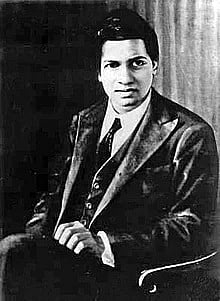Brains of Euler, Euclid, Newton put together
Yet the brain of Ramanujan will be far greater
-Anon, written on the table used by G H Hardy, the English mathematician, mentor and patron of Srinivas Ramanujan at Cambridge, UK
Einstein and India's Ramanujan were similar in the sense that both pooh-poohed formal education to become such universal greats.
-Stephen Hawking, Theoretical Physicist at Cambridge
A neurobiologist friend of mine at Cornell University, United States, informed me that the researchers and neuroscientists at the varsity are re-analysing the mathematical genius of Srinivasa Ramanujan, whose birthday falls on December 22. Since his brain could not be preserved like that of Albert Einstein, Speculative Statistical Neuro Functioning (SSNF) is being applied to assess the stupendous brilliance of the man who died at the age of 32. This method of judging unusually brilliant brains is based on cognitive imprinting on human brains.
According to neuroscientists, Ramanujan must have used both right and left lobes of his brain in unison and he thought numerically! Ramanujan didn't think in terms of words and ideas. He thought digitally (known as 'numero-lingua' in neuro-linguistics) and registered numbers as well as numerics and translated them into complex formulas and signs.
Mathematician-thinkers
Mathematics is considered to be the root of knowledge. That's why, very many great philosophers have also been mathematicians, like Rene Descartes, who gave the world: Cogito ergo sum (I think, therefore, I am), Laplace was a philosopher-logician and mathematician. So was Brahms, Emmanuel Kant, India's Aryabhatta (he wrote a treatise on Shoonyavaad: Nihilism) and Greek philo-mathematician Pythagoras.
Ramanujan's mentor at Cambridge, Professor G H Hardy found an uncanny quality about Ramanujan. His brain immediately explored 17,383 (maximum permutations of a root number), which even the best existing computer in this super-fast age takes nine minutes to find. Yet, the most advanced computer still cannot get to the root of sub-numbers and peripheral number in differential calculus so fast and in precisely the way Ramanujan's brain did it, without the help of any device.
Eidetic memory
This is possible only when the glial cells of human brain have an eidetic or photographic memory of each and every number with functional permutations, predictabilities and probabilities. Einstein had this glial cell extra-intelligence (GCEI) but not as comprehensively as that of Ramanujan. It's humanly impossible. How he did that is a subject of neurological analysis and research because Ramanujan once told a fellow mathematician, Duncan Gosse, that he didn't have to try. Theorems, even unknown number impressions, all-possible values (APV) and their mathematical values (MV), came to him spontaneously.
But here, one must understand that Ramanujan's brain was genetically-programmed to solving the most difficult posers in mathematics. On this count, it was light years ahead of Shakuntala Devi, another number-wizard from another southern state. While Shakuntala Devi's brain memorised numbers, roots and permutations, Ramanujan's brain was into Numerical Innovative Exploration (NIE). In other words, Ramanujan's brain explored numbers and their mathematical probabilities.
Digital thinker
According to the great mathematician Alan Turing (1912-1954), 'Ramanujan's brain already had an in-built template for numbers and their numerical ramifications.' So, while other great mathematicians worked upon them painstakingly to reach a numeric conclusion, Ramanujan's brain never had to meander through the calculated steps and rules. It (brain) just reached the result skipping the rigmarole of formulas and set-patterns.'
The same observation has been reiterated by this year's Nobel-laureate in Physics, Sir Roger Penrose, who's world's foremost mathematical physicist at Oxford. He was the first man to analyse the jottings of Ramanujan in his lost diary, retrieved in 1976. Penrose concluded that, 'Thus far the evolution of human brain hasn't reached the desired level as to understand all the recondite concepts of ultra-advanced mathematics as propounded by the astounding brain of Ramanujan. Only a few humans may comprehend the expanse of Ramanujan's wizardry, that too, only after a millennium! ' (courtesy, 'Shadows of the Mind ', 1994). To cut the matter short, it's still an unresolved mystery as to how a mathematically untrained brain could solve the most intricate problems which even the greatest of brains could not fathom. His genius was otherworldly and simply awe-inspiring.
Innately mathematical and intrinsically number-oriented, Ramanujan never followed a set pattern to come to a mathematical conclusion. His ways were rather crude but much faster than those of the sophisticated mathematicians of the western world. It's time all his diaries and desultory scribbles were assessed as it's believed that he solved many a puzzle in mathematics and the rest of the world is still not in the know of his complete mathematical solutions. The foremost being:
WHEAT ON A CHESSBOARD, 1256
The problem of Sissa's Chessboard, discussed by the Arabic scholar Ibn Khallikan in 1256, has been used for centuries to demonstrate the nature of geometric growth, and is one of the earliest puzzles involving chess. According to legend, King Shirham agreed to give a reward consisting of a grain of wheat on the first square of a chessboard, two grains of wheat on the second square, four grains on the third, and so on for the 64 squares. However, he didn't realise how many grains would be awarded. One way to determine the total is to compute the sum of the first 64 terms of a geometrical progression, 1 + 2 + 2<2> + ... + 2<63>, or 2<64> - 1, which is 18,446,744,073,709,551,615 grains of wheat. This would fill a train reaching 1,000 times around the Earth.
Ramanujan solved it during his stay at Cambridge but couldn't formulate it because of consistent ill-health. It was mentioned by Robert Kenigel in his 1991 book, 'The Man Who Knew Infinity.' He also solved the eternal conundrum of permutations of zero or known in Syllogism as 'Cipher's Probability.'
Let's honour and remember the greatest mathematician of all time. This is also the centenary year of his departure as he shuffled off the mortal coil on April 26, 1920 at Kumbakonam.
The writer is an advanced research scholar of Semitic languages, civilisations and cultures.









